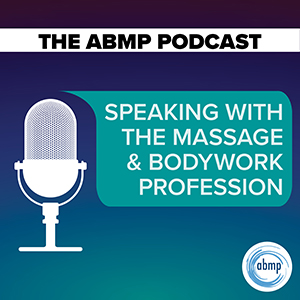The ABMP Podcast launched with a signature series titled “Conversations in Quarantine.”
You can subscribe to The ABMP Podcast in the Apple Podcast Store, Google Play, Spotify, or wherever you access your favorite podcasts. To jump to our landing page, click here.
The goal of the series is to speak with luminaries and experts in and around the massage profession; to talk about the effects of COVID-19 on bodywork practitioners—the fears, the frustrations; and, more importantly, to discuss next steps toward safely reopening our doors when the time is right.
To date, there are five episodes, each covering a slightly different angle in how to move forward.
Episodes 1 and 2:
Cal Cates is the executive director and founder of Healwell, a nonprofit organization that works with children and numerous hospitals and clinical facilities. Cates is also the cofounder of the podcast Massage Therapy Without Borders. Cates sheds light on what it’s like working in a hospital environment and how PPE may be the new norm in our practices moving forward.
Episode 3:
Ruth Werner, author of A Massage Therapist’s Guide to Pathology, discusses her article “What Will It Look Like When We Go Back to Work?” which was featured in the COVID-19 Special Issue of Massage & Bodywork magazine. Werner updates us on virus research and weighs the risks versus benefits of reopening practices.
Episodes 4 and 5:
Nathan Nordstrom, director of massage therapy for Hand & Stone Massage and Facial Spas, speaks to us about their strategy for reopening their 400-plus locations, as well as changes and considerations to the spa and practice environment. Nordstrom lets us know about Hand & Stone’s plans for cleaning protocols, the intake process, and the ethical dilemmas involved in reopening.
Episode 6:
Irene Diamond, consultant, CE provider, and developer of Active Modulation Therapy & Active Muscle Massage, speaks with us about what MTs can do when they can’t offer hands-on work. Diamond speaks about virtual/remote services within practitioners’ scope of practice and other options for serving clients when you can’t provide therapeutic touch.

